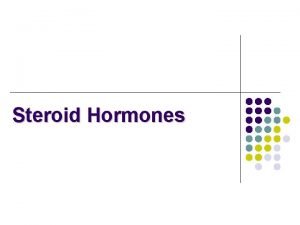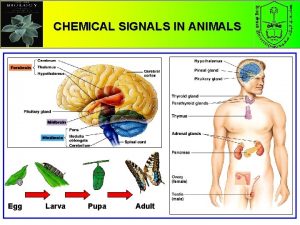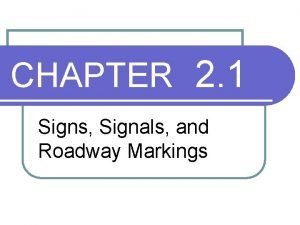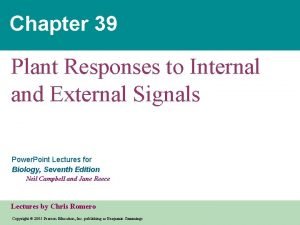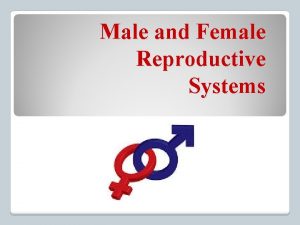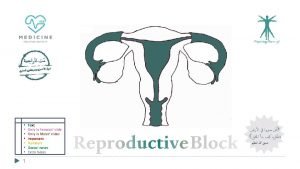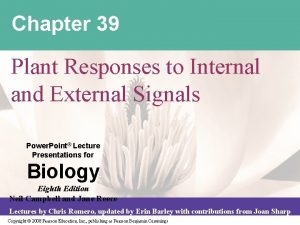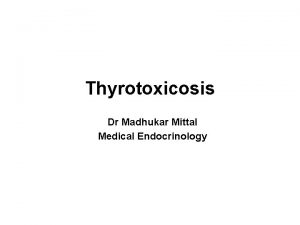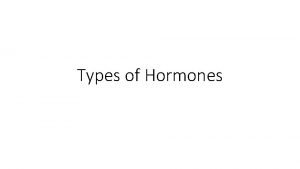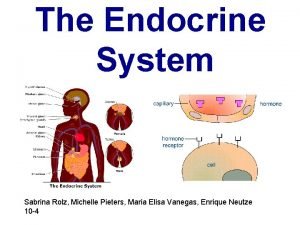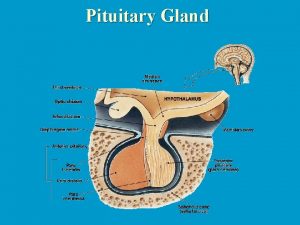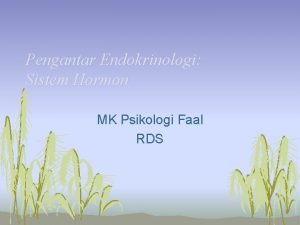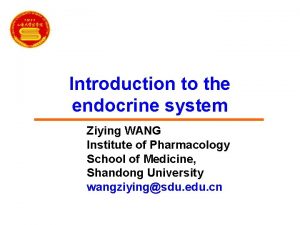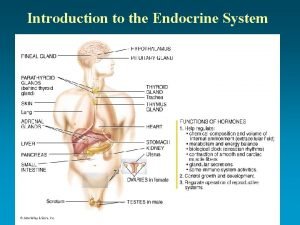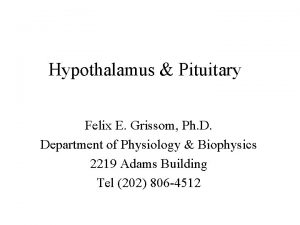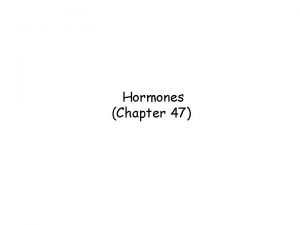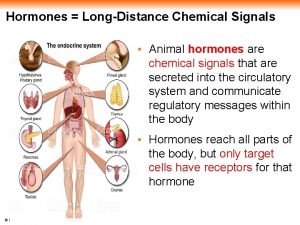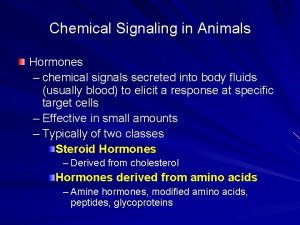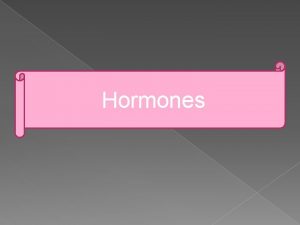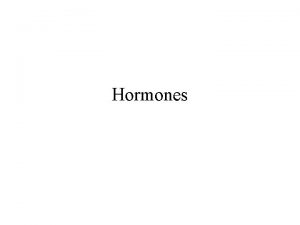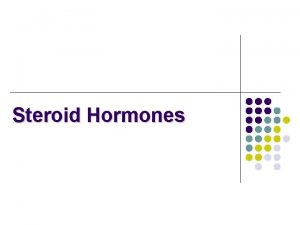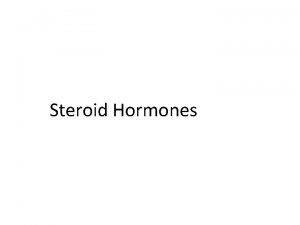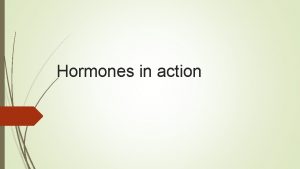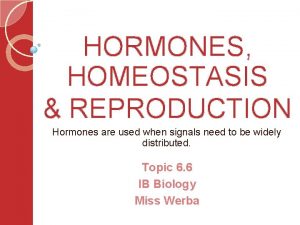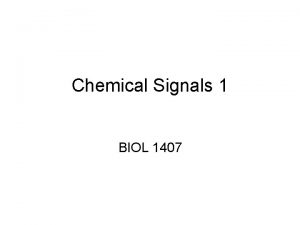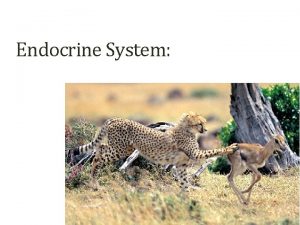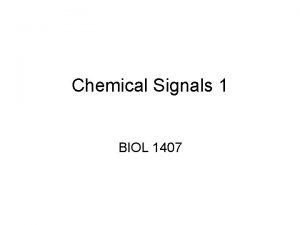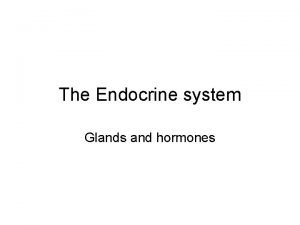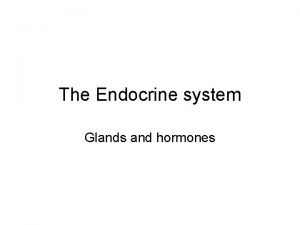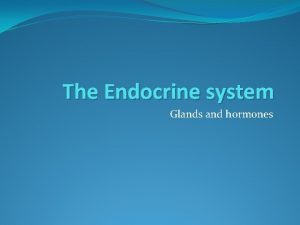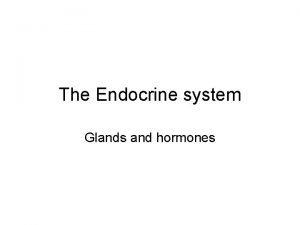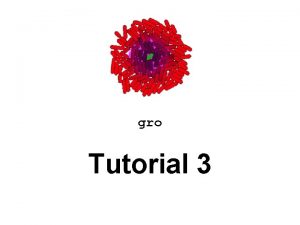Chapter 45 Chemical Signals in Animals Hormones and












































- Slides: 44

Chapter 45 Chemical Signals in Animals Hormones and the Endocrine System Power. Point Lectures for Biology, Seventh Edition Neil Campbell and Jane Reece Lectures by Chris Romero Copyright © 2005 Pearson Education, Inc. publishing as Benjamin Cummings

The Body’s Long-Distance Regulators • An animal hormone – Is a chemical signal that is secreted into the circulatory system and communicates regulatory messages within the body • Hormones may reach all parts of the body – But only certain types of cells, target cells, are equipped to respond Copyright © 2005 Pearson Education, Inc. publishing as Benjamin Cummings

Endocrine & Nervous Systems • Animals have two systems of internal communication and regulation – The nervous system and the endocrine system • The endocrine system and the nervous system act individually and together in regulating an animal’s physiology • The nervous system – Conveys high-speed electrical signals along specialized cells called neurons • The endocrine system, made up of endocrine glands – Secretes hormones that coordinate slower but longer-acting responses to stimuli • The endocrine and nervous systems – Often function together in maintaining homeostasis, development, and reproduction Copyright © 2005 Pearson Education, Inc. publishing as Benjamin Cummings

Hormones • Specialized nerve cells known as neurosecretory cells release neurohormones into the blood • Both endocrine hormones and neurohormones – Function as long-distance regulators of many physiological processes Copyright © 2005 Pearson Education, Inc. publishing as Benjamin Cummings

Control Pathways and Feedback Loops Pathway Example Low blood glucose Stimulus Receptor protein Pancreas secretes glucagon ( ) Endocrine cell Blood vessel Target effectors Response Pathway Stimulus Example Pathway Suckling Hypothalamic neurohormone released in response to Sensory neural and neuron hormonal signals Hypothalamus Sensory neuron Hypothalamus/ posterior pituitary Neurosecretory cell Posterior pituitary secretes oxytocin Blood ( ) vessel Stimulus Neurosecretory cell Hypothalamus secretes prolactin. Blood releasing vessel hormone ( ) Liver Glycogen breakdown, glucose release into blood (a) Simple endocrine pathway Target effectors Response Smooth muscle in breast Milk release Anterior pituitary secretes Endocrine prolactin ( ) cell Blood vessel (b) Simple neurohormone pathway Target effectors Response Figure 45. 2 a–c Copyright © 2005 Pearson Education, Inc. publishing as Benjamin Cummings Mammary glands Milk production (c) Simple neuroendocrine pathway

Feedback Mechanisms • A common feature of control pathways – Is a feedback loop connecting the response to the initial stimulus • Negative feedback – Regulates many hormonal pathways involved in homeostasis Copyright © 2005 Pearson Education, Inc. publishing as Benjamin Cummings

Hormones • Hormones and other chemical signals bind to target cell receptors, initiating pathways that culminate in specific cell responses • Hormones convey information via the bloodstream to target cells throughout the body • Three major classes of molecules function as hormones in vertebrates – Proteins and peptides – Amines derived from amino acids – Steroids Copyright © 2005 Pearson Education, Inc. publishing as Benjamin Cummings

Cell Signaling & Hormonal Response • Signaling by any of these molecules involves three key events – Reception (the target cell’s detection of a signal coming from outside the cell – signal is detected when it binds to a cellular protein on the cell’s surface). – Signal transduction (binding changes receptor protein in some way – initiating transduction which converts the signal to a form that can bring about a cellular response). – Response (transduced signal triggers a specific cellular response). Copyright © 2005 Pearson Education, Inc. publishing as Benjamin Cummings

Cell-Surface Receptors for Water-Soluble Hormones • A water soluble hormone binds to a receptor protein on the surface of a target cell SECRETORY CELL Hormone molecule VIA BLOOD Signal receptor – This interaction triggers a signal transduction pathway that leads to a change in a cytoplasmic function or a change in gene transcription in the nucleus. Figure 45. 3 a Copyright © 2005 Pearson Education, Inc. publishing as Benjamin Cummings TARGET CELL Signal transduction pathway OR Cytoplasmic response DNA Nuclear response NUCLEUS

Intracellular Receptors for Lipid-Soluble Hormones • A lipid-soluble hormone penetrates the target cell’s plasma membrane and binds to an intracellular receptor (either in the cytoplasm or the nucleus) – this complex acts as a transcription factor – typically activating gene expression. Copyright © 2005 Pearson Education, Inc. publishing as Benjamin Cummings

Varying Degrees of Hormonal Effect • The hormone epinephrine has multiple effects in mediating the body’s response to short-term stress Different receptors different cell responses Epinephrine a receptor Glycogen deposits Vessel dilates Vessel constricts (a) Intestinal blood vessel Figure 45. 4 a–c (b) Skeletal muscle blood vessel Different intracellular proteins Copyright © 2005 Pearson Education, Inc. publishing as Benjamin Cummings Glycogen breaks down and glucose is released from cell (c) Liver cell different cell responses

Paracrine Signaling by Local Regulators • In a process called paracrine signaling – Various types of chemical signals elicit responses in nearby target cells • Paracrine signaling involves local regulators – they convey messages between neighboring cells (as opposed to long-distance endocrine signaling by hormones). – These can elicit cell responses more quicly than hormones. Copyright © 2005 Pearson Education, Inc. publishing as Benjamin Cummings

Paracrine Signaling by Local Regulators • Local regulators have various functions and include – Cytokines and growth factors • Immune responses and cell differentiation – Nitric oxide • Relaxes smooth muscle cells which dilates vessels and improves blood flow – Prostaglandins • Several regulatory functions – including smooth muscle contraction in female uterine helping sperm to reach egg Copyright © 2005 Pearson Education, Inc. publishing as Benjamin Cummings

The Endocrine System • The hypothalamus and pituitary integrate many functions of the vertebrate endocrine system • The hypothalamus and the pituitary gland – Control much of the endocrine system Copyright © 2005 Pearson Education, Inc. publishing as Benjamin Cummings

The Major Human Endocrine Glands Hypothalamus Pineal gland Pituitary gland Thyroid gland Parathyroid glands Adrenal glands Pancreas Ovary (female) Testis (male) Figure 45. 6 Copyright © 2005 Pearson Education, Inc. publishing as Benjamin Cummings

Human Endocrine Glands & Their Hormones Table 45. 1 Copyright © 2005 Pearson Education, Inc. publishing as Benjamin Cummings

Human Endocrine Glands & Their Hormones Table 45. 1 Copyright © 2005 Pearson Education, Inc. publishing as Benjamin Cummings

Relation Between the Hypothalamus and Pituitary Gland • The hypothalamus, a region of the lower brain contains different sets of neurosecretory cells Copyright © 2005 Pearson Education, Inc. publishing as Benjamin Cummings

Relation Between the Hypothalamus and Pituitary Gland • The hypothalamus, a region of the lower brain contains different sets of neurosecretory cells. Some of these cells produce direct-acting hormones that are stored in and released from the posterior pituitary, or neurohypophysis. Hypothalamus Neurosecretory cells of the hypothalamus Axon Posterior pituitary HORMONE Figure 45. 7 Copyright © 2005 Pearson Education, Inc. publishing as Benjamin Cummings TARGET Anterior pituitary ADH Kidney tubules Oxytocin Mammary glands, uterine muscles

Relation Between the Hypothalamus and Pituitary Gland • Other hypothalamic cells produce tropic hormones that are secreted into the blood and transported to the anterior pituitary or adenohypophysis Tropic Effects Only FSH, follicle-stimulating hormone LH, luteinizing hormone TSH, thyroid-stimulating hormone ACTH, adrenocorticotropic hormone Neurosecretory cells of the hypothalamus Nontropic Effects Only Prolactin MSH, melanocyte-stimulating hormone Endorphin Portal vessels Nontropic and Tropic Effects Growth hormone Hypothalamic releasing hormones (red dots) HORMONE TARGET Figure 45. 8 FSH and LH Testes or ovaries TSH Thyroid Endocrine cells of the anterior pituitary Pituitary hormones (blue dots) ACTH Prolactin MSH Endorphin Adrenal cortex Mammary glands Melanocytes Pain receptors in the brain Copyright © 2005 Pearson Education, Inc. publishing as Benjamin Cummings Growth hormone Liver Bones

Anterior Pituitary Hormones • The anterior pituitary is a true-endocrine gland – It produces both tropic and nontropic hormones • The tropic hormones of the hypothalamus – Control release of hormones from the anterior pituitary – These hormones regulate the function of the endocrine organs Copyright © 2005 Pearson Education, Inc. publishing as Benjamin Cummings

Tropic Hormones • The four strictly tropic hormones are – Follicle-stimulating hormone (FSH) – Luteinizing hormone (LH) – Thyroid-stimulating hormone (TSH) – Adrenocorticotropic hormone (ACTH) • Each tropic hormone acts on its target endocrine tissue – To stimulate release of hormone(s) with direct metabolic or developmental effects Copyright © 2005 Pearson Education, Inc. publishing as Benjamin Cummings

Anterior Pituitary Hormones • The nontropic hormones produced by the anterior pituitary include – Prolactin • Stimulates mild production and secretion – Melanocyte-stimulating hormone (MSH) • Stimulate the production and release of melanin by melanocytes in the skin and hair – -endorphin • Used as an analgesic in the body to numb or dull pains Copyright © 2005 Pearson Education, Inc. publishing as Benjamin Cummings

Posterior Pituitary Hormones & Nontropic Hormones • The two hormones released from the posterior pituitary act directly on nonendocrine tissues • Oxytocin – Induces uterine contractions and milk ejection • Antidiuretic hormone (ADH) – Enhances water reabsorption in the kidneys Copyright © 2005 Pearson Education, Inc. publishing as Benjamin Cummings

Growth Hormone • Growth hormone (GH) – Promotes growth directly and has diverse metabolic effects – Stimulates the production of growth factors by other tissues Copyright © 2005 Pearson Education, Inc. publishing as Benjamin Cummings

Nonpituitary Hormones • Nonpituitary hormones help regulate metabolism, homeostasis, development, and behavior • Many nonpituitary hormones regulate various functions in the body and include: – Thyroid hormones – Parathyroid Hormone and Calcitonin – Insulin and Glucagon – Adrenal Hormones – Glucocorticoids, such as cortisol – Mineralocorticoids, such as aldosterone – Sex hormones Copyright © 2005 Pearson Education, Inc. publishing as Benjamin Cummings

Thyroid Hormones • The thyroid gland consists of two lobes located on the ventral surface of the trachea – Produces two iodine-containing hormones, triiodothyronine (T 3) and thyroxine (T 4) Copyright © 2005 Pearson Education, Inc. publishing as Benjamin Cummings

Negative Feedback Loops Control Thyroid Hormones • The hypothalamus and anterior pituitary control the secretion of thyroid hormones through two negative feedback loops Hypothalamus Anterior pituitary TSH Thyroid Figure 45. 9 T 3 + Copyright © 2005 Pearson Education, Inc. publishing as Benjamin Cummings T 4

Thyroid Hormones • The thyroid hormones play crucial roles in stimulating metabolism and influencing development and maturation Figure 45. 10 Copyright © 2005 Pearson Education, Inc. publishing as Benjamin Cummings

Parathyroid Hormone and Calcitonin: • Two antagonistic hormones, parathyroid hormone (PTH) and calcitonin play the major role in calcium (Ca 2+) homeostasis in mammals Thyroid gland releases calcitonin. Calcitonin Reduces Ca 2+ uptake in kidneys Stimulates Ca 2+ deposition in bones Blood Ca 2+ level declines to set point STIMULUS: Rising blood Ca 2+ level Homeostasis: Blood Ca 2+ level (about 10 mg/100 m. L) STIMULUS: Falling blood Ca 2+ level Blood Ca 2+ level rises to set point Stimulates Ca 2+ release from bones Parathyroid gland PTH Increases Ca 2+ uptake in intestines Figure 45. 11 Copyright © 2005 Pearson Education, Inc. publishing as Benjamin Cummings Active vitamin D Stimulates Ca 2+ uptake in kidneys

Control of Blood Calcium • Calcitonin, secreted by the thyroid gland – Stimulates Ca 2+ deposition in the bones and secretion by the kidneys, thus lowering blood Ca 2+ levels • PTH, secreted by the parathyroid glands – Has the opposite effects on the bones and kidneys, and therefore raises Ca 2+ levels – Also has an indirect effect, stimulating the kidneys to activate vitamin D, which promotes intestinal uptake of Ca 2+ from food Copyright © 2005 Pearson Education, Inc. publishing as Benjamin Cummings

Insulin and Glucagon: Control of Blood Glucose • Two types of cells in the pancreas secrete insulin and glucagon, antagonistic hormones that help maintain glucose homeostasis and are found in clusters in the islets of Langerhans Copyright © 2005 Pearson Education, Inc. publishing as Benjamin Cummings

Maintenance of Glucose Homeostasis Body cells take up more glucose. Insulin Beta cells of pancreas are stimulated to release insulin into the blood. Liver takes up glucose and stores it as glycogen. STIMULUS: Rising blood glucose level (for instance, after eating a carbohydraterich meal) Blood glucose level declines to set point; stimulus for insulin release diminishes. Homeostasis: Blood glucose level (about 90 mg/100 m. L) Blood glucose level rises to set point; stimulus for glucagon release diminishes. Figure 45. 12 Liver breaks down glycogen and releases glucose into blood. Copyright © 2005 Pearson Education, Inc. publishing as Benjamin Cummings STIMULUS: Dropping blood glucose level (for instance, after skipping a meal) Alpha cells of pancreas are stimulated to release glucagon into the blood. Glucagon

Target Tissues for Insulin and Glucagon • Insulin reduces blood glucose levels by – Promoting the cellular uptake of glucose – Slowing glycogen breakdown in the liver – Promoting fat storage • Glucagon increases blood glucose levels by – Stimulating the conversion of glycogen to glucose in the liver – Stimulating the breakdown of fat and protein into glucose Copyright © 2005 Pearson Education, Inc. publishing as Benjamin Cummings

Diabetes Mellitus • Diabetes mellitus, perhaps the best-known endocrine disorder – Is caused by a deficiency of insulin or a decreased response to insulin in target tissues – Is marked by elevated blood glucose levels • Type I diabetes mellitus (insulin-dependent diabetes) – Is an autoimmune disorder in which the immune system destroys the beta cells of the pancreas • Type II diabetes mellitus (non-insulin-dependent diabetes) – Is characterized either by a deficiency of insulin or, more commonly, by reduced responsiveness of target cells due to some change in insulin receptors Copyright © 2005 Pearson Education, Inc. publishing as Benjamin Cummings

Adrenal Hormones: Response to Stress • The adrenal glands are adjacent to the kidneys and are actually made up of two glands: the adrenal medulla and the adrenal cortex Copyright © 2005 Pearson Education, Inc. publishing as Benjamin Cummings

Catecholamines from the Adrenal Medulla • The adrenal medulla secretes epinephrine and norepinephrine – Hormones which are members of a class of compounds called catecholamines • These hormones – Are secreted in response to stress-activated impulses from the nervous system – Mediate various fight-or-flight responses Copyright © 2005 Pearson Education, Inc. publishing as Benjamin Cummings

Stress Hormones from the Adrenal Cortex • Hormones from the adrenal cortex also function in the body’s response to stress and fall into three classes of steroid hormones: • Glucocorticoids, such as cortisol – Influence glucose metabolism and the immune system • Mineralocorticoids, such as aldosterone – Affect salt and water balance • Sex hormones – Are produced in small amounts Copyright © 2005 Pearson Education, Inc. publishing as Benjamin Cummings

Stress and the Adrenal Gland Stress Spinal cord (cross section) Nerve signals Hypothalamus Releasing hormone Nerve cell Anterior pituitary Blood vessel Adrenal medulla secretes epinephrine and norepinephrine. Nerve cell Adrenal cortex secretes mineralocorticoids and glucocorticoids. ACTH Adrenal gland Kidney (a) Short-term stress response Effects of epinephrine and norepinephrine: 1. Glycogen broken down to glucose; increased blood glucose 2. Increased blood pressure 3. Increased breathing rate 4. Increased metabolic rate Figure 45. 13 a, b 5. Change in blood flow patterns, leading to increased alertness and decreased digestive and kidney activity Copyright © 2005 Pearson Education, Inc. publishing as Benjamin Cummings (b) Long-term stress response Effects of mineralocorticoids: 1. Retention of sodium ions and water by kidneys 2. Increased blood volume and blood pressure Effects of glucocorticoids: 1. Proteins and fats broken down and converted to glucose, leading to increased blood glucose 2. Immune system may be suppressed

Gonadal Sex Hormones • The gonads (testes and ovaries) produce most of the body’s sex hormones: androgens, estrogens, and progestins Copyright © 2005 Pearson Education, Inc. publishing as Benjamin Cummings

Testes • The testes primarily synthesize androgens, the main one being testosterone – Which stimulate the development and maintenance of the male reproductive system • Testosterone causes an increase in muscle and bone mass – And is often taken as a supplement to cause muscle growth, which carries many health risks Copyright © 2005 Pearson Education, Inc. publishing as Benjamin Cummings

Ovaries • Estrogens, the most important of which is estradiol – Are responsible for the maintenance of the female reproductive system and the development of female secondary sex characteristics • In mammals, progestins, which include progesterone – Are primarily involved in preparing and maintaining the uterus Copyright © 2005 Pearson Education, Inc. publishing as Benjamin Cummings

Melatonin and Biorhythms • The pineal gland, located within the brain secretes melatonin Copyright © 2005 Pearson Education, Inc. publishing as Benjamin Cummings

Invertebrate Regulatory Systems • In insects, molting and development are controlled by three main hormones Brain 1 Neurosecretory cells in the brain produce brain hormone (BH), which is stored in the corpora cardiaca (singular, corpus cardiacum) until release. Neurosecretory cells Brain hormone (BH) Corpus cardiacum Corpus allatum Low JH Prothoracic gland Ecdysone Juvenile hormone (JH) 2 BH signals its main target organ, the prothoracic gland, to produce the hormone ecdysone. 3 Figure 45. 15 Ecdysone secretion from the prothoracic gland is episodic, with each release stimulating a molt. EARLY LARVA Copyright © 2005 Pearson Education, Inc. publishing as Benjamin Cummings LATER LARVA PUPA 4 Juvenile hormone (JH), secreted by the corpora allata, determines the result of the molt. At relatively high concentrations of JH, ecdysone-stimulated molting produces another larval stage. JH suppresses metamorphosis. But when levels of JH fall below a certain concentration, a pupa forms at the next ecdysone-induced molt. The adult insect emerges from the pupa. ADULT
 Animals and human language chapter 2
Animals and human language chapter 2 Communicative signals and informative signals
Communicative signals and informative signals Communicative and informative signals
Communicative and informative signals Hormones classification
Hormones classification Empirical formula pogil
Empirical formula pogil Love formula in chemistry
Love formula in chemistry Consumers producers and decomposers
Consumers producers and decomposers Which energy
Which energy Animals that eat both plants and animals
Animals that eat both plants and animals A hormone
A hormone Hormones
Hormones Endocrine glands secrete
Endocrine glands secrete Chapter 18 chemical reactions balancing chemical equations
Chapter 18 chemical reactions balancing chemical equations Kyle douglass
Kyle douglass Signals and systems oppenheim solutions chapter 5
Signals and systems oppenheim solutions chapter 5 Flourescent optic yellow signs
Flourescent optic yellow signs Regulatory sign color
Regulatory sign color Guide and international signs
Guide and international signs Chapter 3 signs signals and pavement markings
Chapter 3 signs signals and pavement markings Chapter 2 signs signals and roadway markings answer key
Chapter 2 signs signals and roadway markings answer key A short section of corrugated roadway
A short section of corrugated roadway Chapter 39 plant responses to internal and external signals
Chapter 39 plant responses to internal and external signals Bioflix activity homeostasis hormones and homeostasis
Bioflix activity homeostasis hormones and homeostasis Male and female hormones
Male and female hormones Male and female hormones
Male and female hormones Bioflix activity homeostasis hormones and homeostasis
Bioflix activity homeostasis hormones and homeostasis Respond to
Respond to Plant hormones and responses
Plant hormones and responses Synthesis and secretion of thyroid hormones
Synthesis and secretion of thyroid hormones Parathyroid gland chief cell
Parathyroid gland chief cell Phyllodes tumor mammogram
Phyllodes tumor mammogram Dichlorine octoxide formula
Dichlorine octoxide formula Section 2 reinforcement classifying chemical reactions
Section 2 reinforcement classifying chemical reactions Section 2 classifying chemical reactions worksheet answers
Section 2 classifying chemical reactions worksheet answers Section 1 chemical changes
Section 1 chemical changes Steroid hormone lipid
Steroid hormone lipid Hypotalanus
Hypotalanus Auxins and gibberellins
Auxins and gibberellins Hormones secreted by adenohypophysis
Hormones secreted by adenohypophysis Hipofisis gland
Hipofisis gland Synthesis of amine hormones
Synthesis of amine hormones Lipid soluble hormones examples
Lipid soluble hormones examples Hypothalamus hormones
Hypothalamus hormones What is the mechanism of action of lipid soluble hormones
What is the mechanism of action of lipid soluble hormones Lipid soluble hormones examples
Lipid soluble hormones examples



